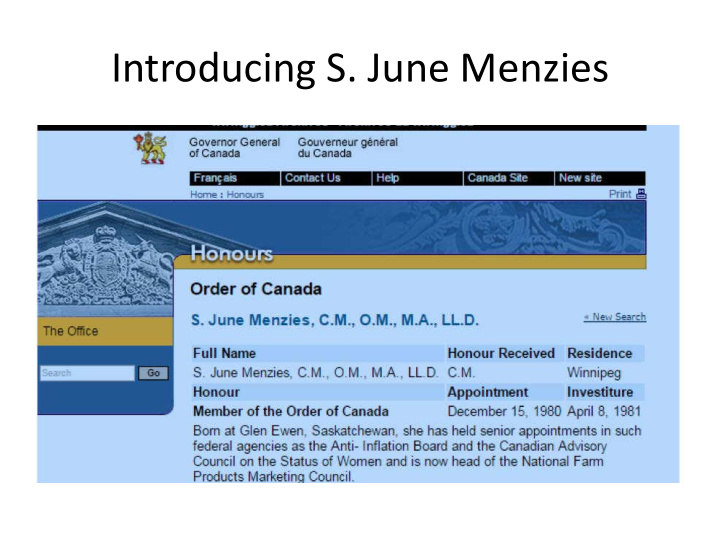



Introducing S. June Menzies
University of Saskatchewan
The Diefenbaker years
Dief and Atherton Early years Social Justice Bill of Rights Commonwealth Roads to Resources
Atherton Diefenbaker was approached by the father of Alfred John “Jack” Atherton, a railway telegrapher accused of causing a crash at Canoe River, British Columbia. In 1950, two trains had collided head-on, killing four locomotive crew members and 17 soldiers bound for Korea. In R. v. Atherton, known as the Canoe River case, he successfully defended Atherton, who was found not guilty of manslaughter. The case was followed nationwide and the acquittal celebrated in the press; it was “one of his major political assets.”
Diefenbaker was born in southwestern Ontario in 1895. In 1903, his family migrated west to the portion of the North-West Territories which would shortly thereafter become the province of Saskatchewan.
The family moved to the Fort Carlton district in 1903 because the doctors of the era recommended the dry prairie climate to help his father’s breathing problems. In 1905, the family moved to Hauge and in 1906 relocated to a homestead near Borden. In 1910, the Diefenbaker family moved to SASKATOON so that John and his brother Elmer could attend high school. Diefenbaker graduated from what is now Nutana Collegiate in the spring of 1912, and entered the UNIVERSITY OF SASKATCHEWAN as a member of the first class to be educated on the new campus. He later lived in Wakaw and Prince Albert.
He grew up in the province, and was interested in politics from a young age.
After brief service in World War I, Diefenbaker became a lawyer. Post card format photo of John Diefenbaker standing against a studio background in his WWI uniform. JGD inscription on reverse reads: "Best regards from Lieut. J. G. Diefenbaker, Canadian Officers Overseas Draft, Regina, Aug 29/16.”
He became known as a defender of minorities. In the courtroom he discovered and honed his dramatic genius. He mastered juries with his powerful and edgy voice, his penetrating stare, his waving arm and accusatory finger, his ridicule and sarcasm, and his command of evidence and the law. He identified naturally with the dispossessed and the poor, with all those who lacked the wealth, John Diefenbaker in legal robes power, and confidence of the British Canadian mainstream; and he argued his cases with passion.
Members of the Progressive Conservative party after Diefenbaker was nominated as candidate, 1929 provincial election, in front of the Prince Albert public library. He contested elections through the 1920s and 1930s with little success until he was finally elected to the House of Commons in 1940.
The Liberal victor in Prince Albert resigned his seat to make way for Prime Minister William Lyon Mackenzie King, who had lost his own seat in York North. King won easily.
Civil Rights A supporter of civil rights for all, Diefenbaker championed the Canadian Bill of Rights and the extension of the vote to First Nations; he also played an important role in the anti-apartheid statement that led to South Africa’s departure from the Commonwealth in 1961.
He was re-elected for Lake Centre in 1945 and 1949.
John and Olive Diefenbaker with Chief William Little Crow at Outlook Saskatchewan
Bill of Rights His determination to guarantee civil rights for all led in 1960 to the Canadian Bill of Rights and to extending the federal vote to First Nations peoples in Canada (prior to that point, the Indian Act generally required First Nations to give up their treaty rights in order to be “enfranchised”). Diefenbaker also nominated James Gladstone, a member of the Blood nation in Alberta, who became the first Aboriginal member of the Senate. In addition, he appointed Canada’s first female Cabinet minister, Ellen Fairclough.
Ellen Fairclough James Gladstone
Prime Minister John Diefenbaker displaying the Canadian Bill of Rights, Ottawa, September 5, 1958 (came into force in August of 1960).
The Diefenbaker era featured the personality and the style of the "man from Prince Albert;” several things now taken for granted were initiated during his administration. Wheat sales to China and agricultural reform revitalized western agriculture.
Social Justice Under the philosophical umbrella of "social justice," the Diefenbaker government restructured programs to provide aid to those in need. In addition to the Agricultural Rehabilitation and Development Act (1961), his government also established a Royal Commission on Health Services (1961) as well as the National Productivity Council (1963) — later named the Economic Council of Canada.
Commonwealth
A tour of the Commonwealth in 1958 reinforced Diefenbaker's belief in the value of that organization and other international bodies. It also helped to define his role as a supporter of the non-white Commonwealth; Diefenbaker played a key role in the 1961 anti-apartheid statement that contributed to South Africa's withdrawal from the Commonwealth.
Canadian delegates to the Empire Parliamentary Association
JGD in Ceylon; Photo signed by the Prime Minister of India, Jawaharlal Nehru, who sits with John Diefenbaker; in Malaya, Singapore and Australia.
Photo of Canadian delegates attending the Empire Parliamentary Association Conference in Wellington, New Zealand. John Diefenbaker's inscription on back reads: "Nov. 1950 New Zealand--Senator Roebuck, JGD, Rene Beaudoin MP, Daniel Johnson MLA.
commonwealth John Diefenbaker Senator Roebuck, Daniel Johnson and other delegates to the Empire Parliamentary Conference.
Roads to Resources The "northern vision" that figured so prominently in the rhetoric of the 1957 and 1958 elections increased public awareness of the Far North and led to some economic development in that region.
John Diefenbaker standing on an outdoor platform and speaking on the telephone with President John F. Kennedy. Taken during the inauguration ceremony for the Canada-Alaska Microwave System, Whitehorse, Yukon, 22 July, 1961.
JGD speaking at the official opening of Inuvik, NWT, July 21, 1961.
John Diefenbaker opening construction of the South Saskatchewan River Dam project
“The man from PA” Questions?
Recommend
More recommend